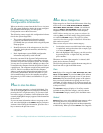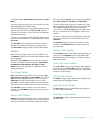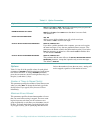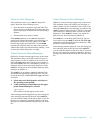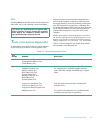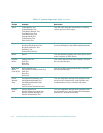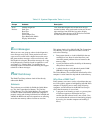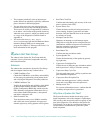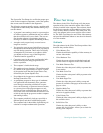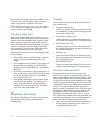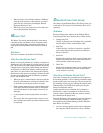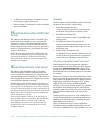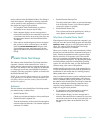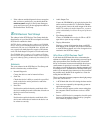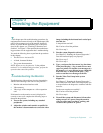
5-12 Dell PowerEdge 4100/180 and 4100/200 Systems Installation and Troubleshooting Guide
•
The computer periodically locks up (becomes un-
usable and must be rebooted), especially at different
places and times in different programs.
•
You get parity errors (any error message that con-
tains the word parity) at any time during operation.
These errors are usually accompanied by a reference
to an address—the location of the portion of memory
where the error occurred—which you should record
on a copy of the Diagnostics Checklist found in
Appendix A.
•
You receive the Memory ECC fault
detected message from the Dell Hardware Instru-
mentation Package (HIP) server management
program. See Chapter 3, “Messages and Codes,” for
more information on this program.
S
ystem Set Test Group
The subtests in the System Set Test Group check the
computer’s basic system board components and verify
their related functions.
Subtests
The subtests that constitute the System Set Test Group
and the computer functions they confirm follow:
•
CMOS Confidence Test
Checks the NVRAM for accessibility and reliability
of data storage by performing a data pattern check
and verifying the uniqueness of memory addresses.
•
CMEM Confidence Test
Verifies the accessibility and reliability of the RAM
on the Extended Industry-Standard Architecture
(EISA) Configuration RAM chip, which stores the
EISA hardware configuration information. On sys-
tems without flash RAM, performs a data pattern
and address uniqueness test.
•
DMA Controller Test
Tests the direct memory access (DMA) controller
and verifies the correct operation of its page and
channel registers by writing patterns to the registers.
•
Real-Time Clock Test
Confirms the functionality and accuracy of the com-
puter’s real-time clock (RTC).
•
System Timers Test
Checks the timers used by the microprocessor for
event counting, frequency generation, and other
functions. Only the functions that can be activated
by software are tested.
•
Interrupt Controller Test
Generates an interrupt on each interrupt request
(IRQ) line to verify that devices using that line can
communicate with the microprocessor and that the
interrupt controllers send the correct memory
addresses to the microprocessor.
•
Reset Button Test
Confirms that the reset button works.
•
System Speaker Test
Checks the functionality of the speaker by generat-
ing eight tones.
•
Coprocessor Calculation Test
Checks the use of different types of numbers and the
math coprocessor’s ability to calculate correctly.
•
Coprocessor Duty Cycle Test
Tests the math coprocessor’s ability to perform com-
plex mathematical operations.
•
Coprocessor Error Exception Test
Verifies the math coprocessor’s ability to handle
errors and to send IRQs to the microprocessor.
•
Multiprocessor Test
For systems with multiprocessors, confirms that the
secondary microprocessor is operational.
Why Run a System Set Test?
The System Set subtests double-check many system
board components, such as the computer’s input/output
(I/O) circuitry, that are tested by other test groups or sub-
tests in the diagnostics. You should run the System Set
Test Group if you are having a problem and cannot iso-
late the failure or malfunction to a particular system
board component.



